
Naughtright Passenger Station, Part 1 of 5: Design
The passenger station turned out to be one of the more difficult structures to bring to life. I struggled with an approach to get the right kind of station to suit the locale, without having to resort to scratchbuilding. In fact, pondering the problem actually kept me awake a couple of nights. What follows is a detailed account—probably far too detailed for the casual visitor—of my quest.
Idea One was to simply make use of "the obvious." It was, after all, a quick and easy way to fill the space. But while the Miller Engineering train station kit is a classic, timeless design, I thought it was a bit too ubiquitous-looking from a model point of view, and it didn't have the flavor I sought.
Idea Two soon followed when the German model-maker 1zu220-Modelle provided a preview of their Woodstock station, one of several new American kits they're adding to their line. I was smitten. It was a beautiful model that seemed to fit my mental picture perfectly, as there are countless stations like this throughout New Jersey and Pennsylvania (Rushland springs to mind as an example). But, to my surprise and disappointment, it was too large for the available space. As my excitement died down, I began to realize it wasn't right for the kind of town I was modeling in the first place; Woodstock was a rural depot, whereas Naughtright is a fairly substantial municipality, and needed a more substantial station.
Idea Three took me back to my youth: I grew up a few blocks from a magnificent Reading station, which I love, and I flirted briefly with the notion of modeling it, or at least something substantially similar. This would present a serious modeling challenge, however—one that I fully intend to undertake one day, but not for this layout (and probably not in Z scale); the extensive kitbashing required would verge on an effort equivalent to scratchbuilding.
Idea Four then took me forward in time to a period when I lived in West Trenton, a tiny old suburb of Trenton. In proportion to the town, the Reading station there is quite imposing; it was probably designed that way to better compete with the Northeast Corridor station in downtown Trenton. Faithfully modeling it would result in a structure entirely too large for the space, so I'd need to do some selective compression—or, more accurately, just tap some of the architectural elements and adapt them into a much more compact design.
I'd already done this for my N scale White River and Northern, and thinking back on it inspired me to do the same in Z using the heap of remains accumulating from Franklin Five and Dime, which was being totally redesigned owing to changes in the layout plan. But when I positioned some parts in place on the layout, it just didn't look right. The problem was that I'd lost sight of the fact that the layout represents a branchline, and a multi-story passenger station was simply inappropriate. So, it was back to searching.
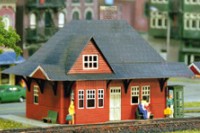
The Miller Engineering station is nice, but doesn't have the right character.
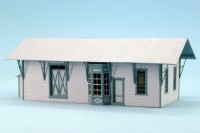
The Woodstock depot is quite beautiful, but it's too rural—and also too large.

I grew up a few blocks away from this magnificent Reading station.
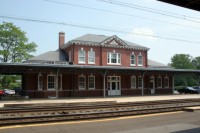
For 12 years I lived a few blocks away from this grand Reading station.
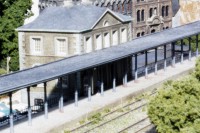
Newton station on the WR&N is loosely based on the West Trenton station.
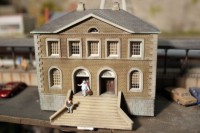
Newton station is now Laube station on Rick Spano's Sceniced and Undecided.
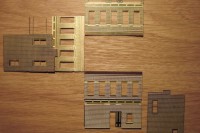
I was about to start cutting up these parts when I changed direction again.
Copyright © 2007-2013 by
David K. Smith. All Rights Reserved.
Miller Engineering and 1zu220-Modelle product photos used with permission.